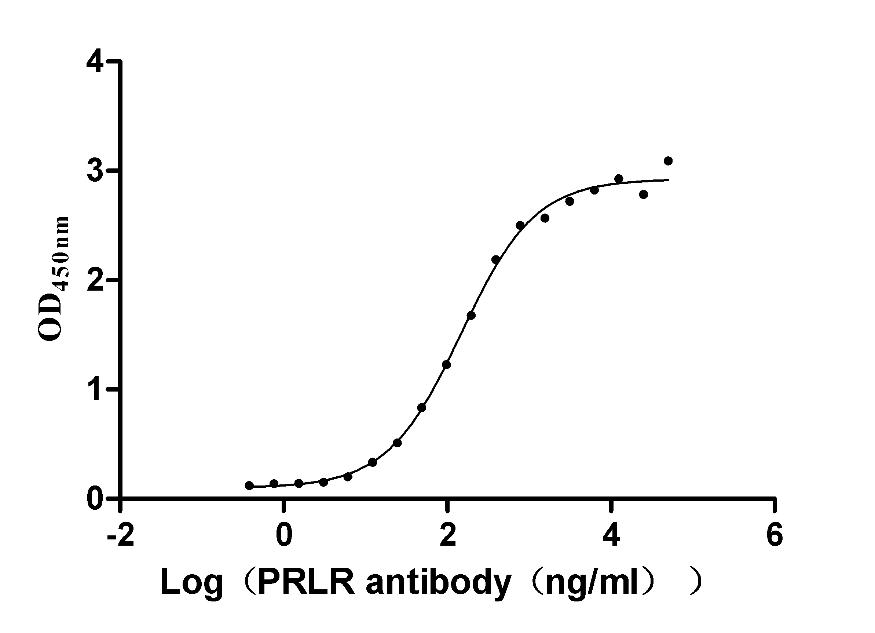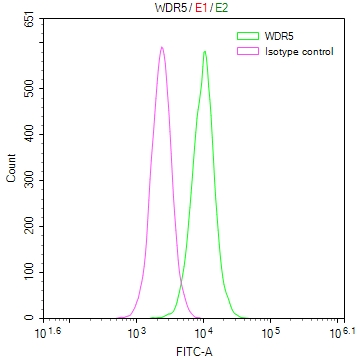PRLR Recombinant Monoclonal Antibody
-
中文名稱(chēng):PRLR重組抗體
-
貨號(hào):CSB-RA018727A0HU
-
規(guī)格:¥1320
-
圖片:
-
The Binding Activity of Human PRLR with Anti-PRLR recombinant antibody
Activity: Measured by its binding ability in a functional ELISA. Immobilized Human PRLR (CSB-MP018727HU1d7) at 2 μg/mL can bind Anti-PRLR recombinant antibody, the EC50 is 126.8-171.9 ng/mL. -
The Binding Activity of Mouse Prlr with Anti-PRLR recombinant antibody
Activity: Measured by its binding ability in a functional ELISA. Immobilized Mouse Prlr at 5 μg/mL (CSB-MP018727MO) can bind Anti-PRLR recombinant antibody, the EC50 is 4.021-8.706 ng/mL.
-
-
其他:
產(chǎn)品詳情
-
Uniprot No.:
-
基因名:
-
別名:PRLR; Prolactin receptor; PRL-R
-
反應(yīng)種屬:Human, Mouse
-
免疫原:Recombinant Human PRLR protein
-
免疫原種屬:Homo sapiens (Human)
-
標(biāo)記方式:Non-conjugated
-
克隆類(lèi)型:Monoclonal
-
抗體亞型:hIgG2
-
純化方式:Affinity-chromatography
-
克隆號(hào):1D3
-
濃度:It differs from different batches. Please contact us to confirm it.
-
保存緩沖液:Preservative: 0.03% Proclin 300
Constituents: 50% Glycerol, 0.01M PBS, PH 7.4 -
產(chǎn)品提供形式:Liquid
-
應(yīng)用范圍:ELISA
-
Protocols:
-
儲(chǔ)存條件:Upon receipt, store at -20°C or -80°C. Avoid repeated freeze.
-
貨期:Basically, we can dispatch the products out in 1-3 working days after receiving your orders. Delivery time maybe differs from different purchasing way or location, please kindly consult your local distributors for specific delivery time.
相關(guān)產(chǎn)品
靶點(diǎn)詳情
-
功能:This is a receptor for the anterior pituitary hormone prolactin (PRL). Acts as a prosurvival factor for spermatozoa by inhibiting sperm capacitation through suppression of SRC kinase activation and stimulation of AKT. Isoform 4 is unable to transduce prolactin signaling. Isoform 6 is unable to transduce prolactin signaling.
-
基因功能參考文獻(xiàn):
- In a replication study of the association between the prolactin receptor gene intron C/T polymorphism (rs37389) and recurrent miscarriage, no association was found. PMID: 28980840
- Low PRLR expression is associated with Triple Negative Breast Cancer. PMID: 27480353
- These results illustrate promising antitumor activity against PRLR-positive breast cancer xenografts and support the evaluation of anti-PRLR antibody-drug conjugate as potential therapeutic agents in breast cancer. PMID: 28377489
- Prl receptor is expressed at different levels in the majority of glioblastoma multiforme tumors. Prolactin stimulation resulted in increased STAT5 phosphorylation and increased cellular invasion. PMID: 27788487
- PRLRI146L and PRLRI176V variants are not associated with breast cancer or multiple breast fibroadenomas risk. PMID: 27575941
- This study identified 4 PRLR variations (p.Ile76Val, p.Ile146Leu, p.Glu108Lys and p.Glu554Gln) in 16 Sporadic Prolactinoma in Humans. PMID: 26641246
- results highlight PRLR as an independent predictor of favorable prognosis in human breast cancer PMID: 26317306
- Two markers for the PRL peptide gene and three markers for the prolactin receptor (PRLR) gene were genotyped. PMID: 26513615
- The prolactin receptor is constitutively expressed on regulatory T and effector T cells in systemic lupus erythematosus patients, and this expression is higher than in healthy individuals. PMID: 26844452
- There is a possible role for PRLR in the progression of cervical cancer. PMID: 24990775
- Study shows that position 146 plays a central role in directing intrinsic properties of the PRLR, including extracellular domain folding, PRL-responsiveness, and ligand-independent activity of the receptor. PMID: 25524456
- Data suggest that (1) cell membrane/lipid bilayer binding of PRLR and (2) tyrosine phosphorylation of PRLR intracellular domain are independent. PMID: 25846210
- long PRLR plays an important role in breast cancer metastasis. PMID: 26095602
- a residue quartet in the extracellular membrane proximal domain of the homodimeric cytokine receptor prolactin receptor is a key regulator of intracellular signaling discrimination PMID: 25784554
- PRL induced transient signaling pathways in neurons and modulated ion channels. [review] PMID: 24758841
- exposure to prolactin increases TNF-alpha release from CD14(+) monocytes of rheumatoid arthritis patients, which can be abolished by PRLR gene silencing or treating with MAPK inhibitor. PMID: 24997655
- High MFAB expression is associated with testicular germ cell tumor and glioblastomas. PMID: 24391856
- Negative/low expression is associated with poorly differentiated and larger breast tumors in Poland PMID: 24249584
- Major changes in prolactin receptor conformation and dimerization affinity are triggered by single mutations in critical regions of D1. PMID: 24735798
- PRL-R attenuation post-transcriptionally increased ZnT2 abundance and redistributed intracellular Zn pools into lysosomes and mitochondria. PMID: 24333596
- Hypertrimethylation on H3K27 of the p53 gene promoter region due to elevated expression of DeltaS2 PRLR by alternative splicing of the pre-mRNA in its full-length form might serve as a new mechanism underlying prostate cancer PMID: 24032713
- Data suggest that signal transduction via prolactin and prolactin receptor plays role in trophoblast cell migration and invasion; PRLR is expressed by extravillous cytotrophoblasts and first-trimester placental bed tissue. PMID: 23849393
- PRL-induced transient signaling in sensory neurons is governed by PI3K or PKCepsilon, mediated via the PRLR-S isoform, and transient effects mediated by PRLR-S are inhibited by presence of PRLR-L in these cells. PMID: 24142695
- SNPs of the PRLR gene 5' UTR and promoter region are associated with increased risk for gestational diabetes in a population of Chilean subjects. PMID: 23651351
- Thus, the familial hyperprolactinemia appears to be due to a germline, loss-of-function mutation in PRLR, resulting in prolactin insensitivity. PMID: 24195502
- Results demonstrate a novel function for hepatic PRLR in the regulation of insulin sensitivity and provide important insights concerning the nutritional regulation of PRLR expression. PMID: 23775766
- Our data suggest that prolactin receptor presence meaningfully affects growth hormone receptor use in breast cancer cells. PMID: 23192981
- The prolactin receptor transactivation domain is associated with steroid hormone receptor expression and malignant progression of breast cancer PMID: 23159947
- Our results indicate no significant association of prolactin and PRLR polymorphisms with clozapine response, tardive dyskinesia diagnosis or its severity in patients with schizophrenia PMID: 21305610
- can be activated by three sequence-diverse human hormones: prolactin, GH, and placental lactogen [review] PMID: 22577091
- PRLr isoforms expression and PRLr subcellular localisation are altered in parathyroid tumours PMID: 22606260
- The structure of the human prolactin receptor reveals a structural link between the WSXWS motif, hormone binding, and receptor dimerization and we propose it as a general mechanism for class 1 receptor activation. PMID: 22325776
- PRL signaling through the long form prolactin receptor causes reduced fatty acid oxidation, increased lipid storage, glucose intolerance, and obesity. PMID: 21989556
- data provide limited support for an association between common variations in PRLR and breast cancer risk PMID: 21470416
- The association of the PRLr with HMGN2 enables Stat5a-responsive promoter binding, thus facilitating transcriptional activation and promoting anchorage-independent growth. PMID: 21816901
- Our study suggests the prolactin receptor gene is a molecular target that may be important in the pathogenesis and progression of lobular neoplasia PMID: 20658264
- Enhanced complex formation of ERalpha dimer with SP1 and C/EBPbeta by E2 has an essential role in the transcriptional activation of the hPRLR gene. PMID: 21670145
- Data show that cells expressing higher long:short PRLR ratios had increased growth, survival and migration in response to PRL and suggest that PRLR antagonists may be therapeutically beneficial in ovarian cancer. PMID: 21775057
- Endogenous GH receptor(GHR) and PRLR associate, possibly as a GHR-PRLR heterodimer, in human breast cancer cells and GH signaling in these cells is largely mediated by the PRLR in the context of both PRLR-PRLR homodimers and GHR-PRLR heterodimers. PMID: 21310852
- The positive correlations in positivity rate between the PRL-R and ER/PR expressions are found only in CerbB-2 positive patients with breast cancer. PMID: 20335148
- SIRPalpha modulates PRL receptor-associated signaling as a function of integrin occupancy by mediating integrin-PRL receptor cross-talk and contributing to breast cancer biology. PMID: 20826546
- both Zn(2+) and human PRLr binding influence human PRL conformers in an interdependent fashion PMID: 21510945
- Functional impact of manipulation on the relative orientation of human prolactin receptor domains. PMID: 21591677
- Progesterone induces expression of the prolactin receptor gene through cooperative action of Sp1 and C/EBP transcription factors PMID: 21238538
- Rabbit antibodies have high titer and could specifically recognize each isoform of PRLR in breast cancer cell lines and human breast carcinoma biopsies. PMID: 21144038
- Prolactin receptor signaling contributes to the local inflammatory response within the atherosclerotic plaque and thus to atherogenesis. PMID: 21068074
- Blockade of the PRLR represents a novel treatment for patients with advanced breast or prostate cancer with limited therapeutic options. PMID: 20846877
- acetylation and deacetylation provide the rheostat-like regulation for the cytokine receptor PRLR in its cytoplasmic loop dimerization and subsequent STAT5 activation PMID: 20962278
- This study allowed to visualize for the first time the loop L5 spanning PRLR2 residues Thr133-Phe140, revealing its central implication for the three intermolecular interfaces of the 1:2 complex between natural prolactin and two PRLR chains. PMID: 20875426
- prolactin receptor expression is common in colorectal cancer PMID: 20453834
顯示更多
收起更多
-
相關(guān)疾?。?/div>Multiple fibroadenomas of the breast (MFAB); Hyperprolactinemia (HPRL)亞細(xì)胞定位:Membrane; Single-pass type I membrane protein.; [Isoform 7]: Secreted.蛋白家族:Type I cytokine receptor family, Type 1 subfamily組織特異性:Expressed in breast, placenta, kidney, liver and pancreas.數(shù)據(jù)庫(kù)鏈接:
Most popular with customers
-
-
YWHAB Recombinant Monoclonal Antibody
Applications: ELISA, WB, IF, FC
Species Reactivity: Human, Mouse, Rat
-
Phospho-YAP1 (S127) Recombinant Monoclonal Antibody
Applications: ELISA, WB, IHC
Species Reactivity: Human
-
-
-
-
-






















